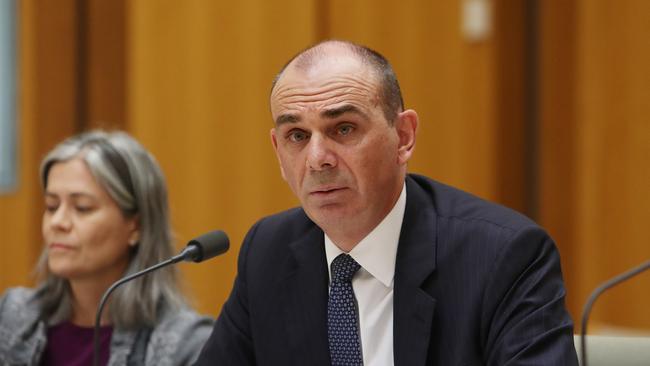APRA lends banks a hand
The freeing up of lending criteria will strengthen the banks’ ability to support borrowers.

Banks’ ability to lend more freely and at larger amounts will be bolstered after the prudential regulator announced plans to relax interest rate hurdles built into mortgage assessments.
The proposed move is set to help first-home buyers and the flailing housing market, where borrowers have found it increasingly difficult to secure credit.
That was exacerbated by the Hayne royal commission and a stricter interpretation of responsible lending rules by the banks.
The Australian Prudential Regulation Authority wrote to banks on Tuesday to begin consultation on the plan which if enacted will see the lending environment move closer to a pre-December 2014 regime.
It is another boost for the banking sector after Scott Morrison’s government was returned to power at the weekend, equating to lower bank levies and no changes to negative gearing rules.
Under its plan, APRA wants to scrap part of an interest rate serviceability hurdle introduced in 2014 which ensured borrowers could repay rates of 7 per cent or a 2 per cent buffer over their mortgage rate. The rule meant banks had to impose the higher of the two measures and they typically added a further 25 basis points to both thresholds.
APRA wants to get rid of the 7 per cent and allow the assessment level to be determined by financial institutions as they gauge if a borrower can repay a loan.
The regulator also wants the 2 per cent buffer over the loan’s interest rate, which banks raised to 2.25 per cent, lifted to 2.5 per cent.
Industry sources suggested APRA’s plan would give borrowers 75 to 100 basis points of further breathing space on their loan assessment. It is also likely to inject more confidence into the market and play a role in influencing borrower behaviour.
With official interest rates at record lows, and the Reserve Bank expected to cut rates even lower, parts of the banking sector have in recent months stepped up calls for a review of loan interest rate hurdles and buffers.
Switzer Asset Management portfolio manager Shawn Burns said the mooted measures would be beneficial to banks, first-home buyers and those on the margin of being able to obtain a home loan.
“It is definitely positive. I think the question mark is to what extent? For the banks (finding it) so difficult to get their top line growing any help is good news. It is another [lever] to try and stabilise the housing market and help people avoid a crunch. We are not going to see 7 per cent interest rates for quite a while.”
APRA chairman Wayne Byres said the operating environment for banks had evolved since 2014, spurring a review of the regulator’s guidance: “With interest rates at record lows and likely to remain at historically low levels for some time the gap between the 7 per cent floor and actual rates paid has become quite wide in some cases — possibly unnecessarily so.
“In addition, the introduction of differential pricing in recent years, with a substantial gap emerging between interest rates for owner-occupiers with principal-and-interest loans on the one hand and investors with interest-only loans on the other, has meant the merits of a single floor rate across all products have been substantially reduced.”
APRA said it would consult on the proposals for four weeks ahead of releasing final guidance.
The Customer Owned Banking Association’s chief, Michael Lawrence, said the proposal would be welcomed by Australians who struggled to fit into loan serviceability buffers.
“Lowering the interest rate floor by even 1 per cent could take approximately $60 per week off the assessed repayment on a $400,000, 30-year loan,” he said.
The proposal could also help improve competition in the market by reducing the advantage enjoyed by non-ADI (authorised deposit taking institution) lenders, who don’t have to comply with APRA regulations.”
Westpac welcomed APRA’s consultative process and the Commonwealth Bank applauded the opportunity to consult on the measures.
Earlier this month, ANZ chief executive Shayne Elliott expressed support for a rethink of the interest rate hurdle and buffer levels. He said they had become less useful as official rates hovered at record lows and cuts loomed.
“The lower interest rates get the less likely it is that rates are going to get to 7.25 per cent any time soon,” Mr Elliott said.
“At some point you need to rethink it. Commonsense says it should be relative to where the interest rate cycle is.”
Bank stocks enjoyed a second day of strong gains after the APRA announcement, outpacing the local bourse which edged up 0.4 per cent. Westpac shares led the rally, rising 2.7 per cent, followed by ANZ at 2.1 per cent, CBA at 2 per cent and National Australia Bank at 1.5 per cent.
ANZ’s Australia economics boss David Plank yesterday said APRA’s announcement represented “a material easing” in the credit constraint facing households: “The use of a floor won’t disappear but it seems reasonable to think it will come down some way from the current 7.25 per cent used by the major banks. Certainly to something with a six handle on it.”
The proposed ditching of the APRA rate serviceability requirements is the latest in a string of measures to remove restrictions on the sector. APRA has dumped its 10 per cent growth cap on investor lending and cast aside its 30 per cent limit on interest-only lending.





To join the conversation, please log in. Don't have an account? Register
Join the conversation, you are commenting as Logout